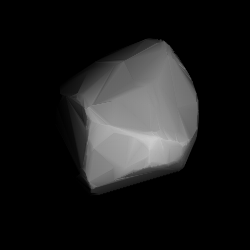237 Coelestina
Appearance
 | |
| Discovery | |
|---|---|
| Discovered by | Johann Palisa |
| Discovery date | 27 June 1884 |
| Designations | |
| (237) Coelestina | |
| Pronunciation | /ˌsɛləˈstiːnə, -ˈstaɪnə/ SEL-ə-STEE-nə, -STY-nə |
| A884 MA | |
| Main belt | |
| Orbital characteristics[1] | |
| Epoch 31 July 2016 (JD 2457600.5) | |
| Uncertainty parameter 0 | |
| Observation arc | 131.81 yr (48143 d) |
| Aphelion | 2.96365 AU (443.356 Gm) |
| Perihelion | 2.56551 AU (383.795 Gm) |
| 2.76458 AU (413.575 Gm) | |
| Eccentricity | 0.072007 |
| 4.597 yr (1,679.0 d) | |
Average orbital speed | 17.92 km/s |
| 253.418° | |
| 0° 12m 51.905s / day | |
| Inclination | 9.74247° |
| 84.3141° | |
| 199.113° | |
| Physical characteristics | |
| Dimensions | 41.08±1.4 km |
| 29.215 h (1.2173 d) | |
| 0.2108±0.016 | |
| Temperature | unknown |
| S | |
| 9.24 | |
237 Coelestina is a stony main belt asteroid. It was discovered by Austrian astronomer Johann Palisa on 27 June 1884 in Vienna and was named after Coelestine, wife of astronomer Theodor von Oppolzer. This minor planet is orbiting the Sun at a distance of 2.76 AU with a low eccentricity of 0.072 and an orbital period of 4.60 yr. The orbital plane is inclined at an angle of 9.74° to the plane of the ecliptic.[1]
Photometric data collected during March 2021 was used the generate a lightcurve for 237 Coelestina. This showed a rotation period of 29.062±0.009 h with a brightness variation of 0.24 magnitude.[2]
References
[edit]- ^ a b "237 Coelestina". JPL Small-Body Database. NASA/Jet Propulsion Laboratory. Retrieved 12 May 2016.
- ^ Farfan, Rafael Gonzalez; et al. (April 2022). "The Rotation Periods of 3 Juno, 28 Bellona, 129 Antigone, 214 Aschera, 237 Coelestina, 246 Asporina, 382 Dodona, 523 Ada, 670 Ottegebe, 918 Itha, 1242 Zambesia, 1352 Wawel, 1358 Gaika, 4155 Watanabe, and 6097 Koishikawa". Bulletin of the Minor Planets Section of the Association of Lunar and Planetary Observers. 49 (2): 136–140. Bibcode:2022MPBu...49..136F.
External links
[edit]- The Asteroid Orbital Elements Database
- 237 Coelestina at AstDyS-2, Asteroids—Dynamic Site
- 237 Coelestina at the JPL Small-Body Database
